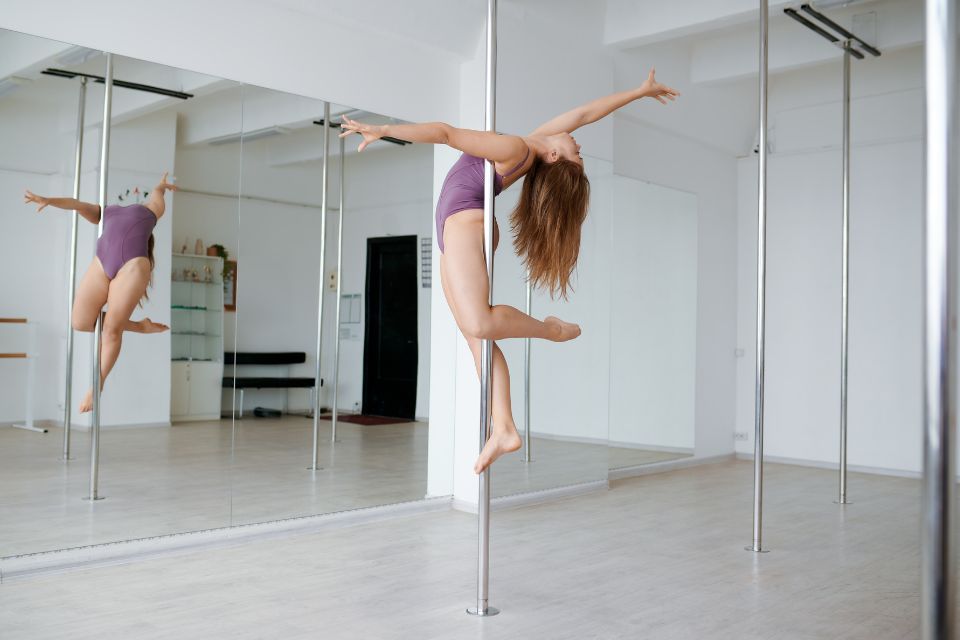Pole dancing is an incredibly diverse activity that defies simple definition, incorporating elements from various realms such as sports, performance art, dance, and physical workout.
This article will cover how pole dancing is much more than what meets the eye; it’s a complex and engaging discipline that requires not only physical strength and technique but also creativity and expression.
You’ll learn about its competitive edge, artistic nuances, rhythmic dance qualities, and its effectiveness as a full-body workout.
Each aspect contributes to why pole dancing has grown in popularity and acceptance as both an art form and a means to keep fit.
This exploration will help you understand the depth and breadth of pole dancing and perhaps inspire you to appreciate or engage with it in a new way.
Key Takeaways
- Pole dancing is a multifaceted activity that combines the elements of sport, performance, dance, and fitness.
- It involves competitions and strict physical requirements, qualifying it as a sport.
- As a performance, pole dancing allows for emotional and artistic expression, often including a narrative.
- The activity incorporates choreography and rhythm, making it a form of dance.
- Pole dancing is an effective full-body workout that enhances strength, flexibility, and endurance.
Pole Dancing as a Sport
Pole dancing is often recognized as a sport due to its inclusion in various sports championships and its rigorous physical demands.
Competitions like the World Pole Sports Championships require participants to display not only their technical skills but also creativity and athleticism, much like gymnastics.
The scoring system in these competitions evaluates the participants on elements such as difficulty, execution, and artistic interpretation, which highlights the sport’s complexity and competitive nature.
This aspect of pole dancing pushes athletes to continually improve their strength, flexibility, and technique to excel and possibly win titles.
Pole Dancing as a Performance
Pole dancing as a performance extends beyond mere physical movement to incorporate storytelling and emotional expression.
Performers often craft routines that convey a theme or narrative, using music and costumes to enhance the artistic aspect of their presentation.
This can be seen in various showcases and theater productions that use pole dancing as a central element.
The ability to engage an audience emotionally and tell a story through body movements places pole dancing in the realm of performance arts akin to ballet or modern dance.
This expressive nature allows performers to connect with their audience on a deeper level, making each performance unique and impactful.
Pole Dancing as a Dance
In the realm of dance, pole dancing involves choreographed movements set to music, emphasizing rhythm and body expression.
It combines elements from various dance styles, including modern dance, ballet, and even street dance, making it a diverse and dynamic form of dance.
The choreographic routines require dancers to flow seamlessly from one move to another, maintaining grace and fluidity, which are hallmark traits in dance. This aspect celebrates the creative and rhythmic expression of the dancer, allowing them to explore different genres of music and movement styles.
Through dance, pole performers can showcase their technical skill while also expressing their personal dance style and creativity.
Pole Dancing as a Workout
Pole dancing is equally effective as a workout, providing numerous physical benefits. It engages multiple muscle groups, offering a comprehensive full-body exercise that enhances muscle tone, strength, and cardiovascular health.
The variety of moves practiced in pole dancing—from spins and climbs to holds and inversions—requires significant muscle engagement, particularly from the core, arms, and legs.
Furthermore, the flexibility demanded by the sport helps improve overall body flexibility and reduces the risk of injury.
This makes pole dancing an excellent alternative to traditional gym workouts, as it combines strength training, flexibility, and aerobic exercise in a fun and challenging way.
Conclusion
Pole dancing is a captivating and multifaceted activity that intertwines the worlds of sport, performance, dance, and fitness.
It challenges participants physically while offering a platform for artistic expression and emotional storytelling.
As you can appreciate the diverse aspects of pole dancing, it becomes clear just how deep and enriching this discipline can be—whether one participates in it for competitive purposes, performs it on stage, explores its rhythmic dance elements, or engages in it for physical fitness.
The many faces of pole dancing make it a unique and rewarding pursuit worth exploring or appreciating in all of its forms.
Frequently Asked Questions
- Is pole dancing suitable for beginners? Yes, pole dancing is suitable for beginners. Many studios offer introductory classes that focus on basic moves and safety, making it accessible to people of all fitness levels and backgrounds.
- What should I wear for a pole dancing class? It’s recommended to wear shorts and a sports bra or tank top for pole dancing classes. Exposed skin helps grip the pole, which is necessary for performing various moves. Avoid lotions or oils before class, as they can make the pole slippery.
- How often should I practice pole dancing to see improvements? Consistency is key to progressing in pole dancing. Practicing 2-3 times a week can help you see improvements in strength, flexibility, and skill. As with any physical activity, the more effort you put in, the more results you’ll see.
- Can pole dancing help with weight loss? Yes, pole dancing can help with weight loss. It combines strength training, flexibility, and cardio, all of which are effective for burning calories and improving body composition. Regular practice, combined with a balanced diet, can contribute to weight loss and muscle toning.
- Is pole dancing safe? Pole dancing is safe if learned and practiced correctly. It’s important to learn from qualified instructors who can teach proper techniques and spotting. Using correctly installed equipment and following safety guidelines also minimizes the risk of injury.

